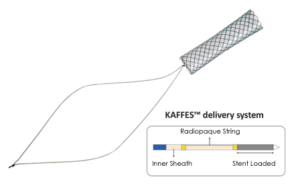Endoscopy Supplies
Gastroenterology
- Niti-S™ Self-Expandable Metal Stent
- RFA Treatment
- Solar™ GI High-Resolution Manometry Available In Canada
- Solid State Catheters Available in Canada
Available In The USA
Interventional Radiology Kaffes™ Stent
Category: Interventional Biliary Stents

To treat anastomic strictures after liver transplantation
Product Description
Characteristic waist at mid-portion of the stent: Waist shape of the stent allows strong radial force and preventing migration
Short length of stent: Using a short stent across the stricture prevents to impart pressure over a large area of normal duct by reducing the potential risk of necrosis and fibrosis
Long platinum radio-paqued retrieval string: The long platinum string helps easy removal from the high up location of CBD
Covered part can prevent bile leak through transluminal track between stomach and left hepatic duct.
Uncovered part can prevent migration and cholangitis without obstructing side branches of hepatic ducts.
Flared end is located out of the stomach wall preventing migration into hepatic duct
Indication
Anastomic strictures after liver transplantation
Clinical Reference
A randomized trial of a fully covered self-expandable metallic stent versus plastic stents in anastomotic biliary strictures after liver transplantation
by Arthur Kaffes et al [Therap Adv Gastroenterol. 2014 Mar;7(2):64-71]
Key Resources
Interventional Radiology Breakthrough: Kaffes™ Stent Revolutionizes Vascular Care
In the dynamic field of interventional radiology, where innovation constantly pushes boundaries, the Kaffes™ Stent emerges as a game-changer. This cutting-edge medical device is transforming vascular care and reshaping the way physicians approach complex cases.
The Kaffes™ Stent, named after its pioneering inventor, Dr. Elena Kaffes, represents a leap forward in the treatment of vascular diseases. Unlike traditional stents, this next-gen device combines advanced materials with a unique design. Its biomimetic structure mimics the natural flow of blood vessels, reducing turbulence and minimizing the risk of complications.
What sets the Kaffes™ Stent apart is its adaptability. Its modular design allows for customization, ensuring a perfect fit in even the most challenging anatomical variations. This innovation translates into improved patient outcomes and reduced procedural complications.
Additionally, the Kaffes™ Stent is compatible with various imaging modalities, enabling real-time monitoring during procedures. This real-time feedback empowers interventional radiologists to make precise adjustments, further enhancing patient safety and treatment efficacy.
In conclusion, the Kaffes™ Stent is a testament to the relentless pursuit of excellence in interventional radiology. Its groundbreaking design and adaptability promise a brighter future for patients with vascular diseases, reaffirming the critical role of innovation in healthcare. As this technology continues to evolve, we can anticipate even more remarkable advancements in the field, revolutionizing patient care.
